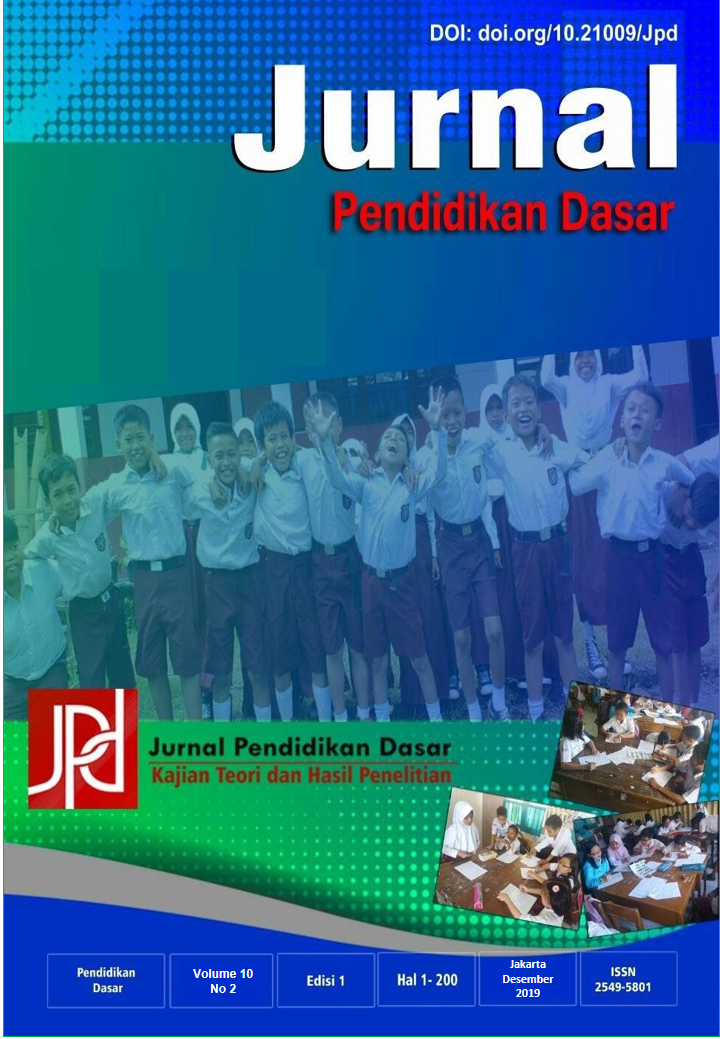INTEGRASI KONSEP KEBENCANAAN DALAM IMPLEMENTASI KURIKULUM 2013 DI SEKOLAH DASAR
DOI:
https://doi.org/10.21009/jpd.v10i2.13439Keywords:
Integration, Disaster Concepts, Elementary Thematic, 2013 CurriculumAbstract
A disaster is an event that has a large impact on human populations, both natural disasters, non-natural disasters, and social disasters. Permendikbud number 33 of 2019 concerning the Implementation of the Disaster Safe Education Unit Program to prepare disaster response education units. Through this paper we will study through the integration of the concept of disaster in the implementation of the 2013 curriculum in elementary schools, starting with how the paradigm of disaster management in Indonesia, in the context of the elementary school curriculum, thematic learning from the 2013 curriculum that can be integrated into the concept of disaster. The method used is a literature review of legislation relating to the disaster, research results, modules, books, practical manuals. Furthermore, it will be adapted through content analysis related to the 2013 curriculum and the concept of disaster. The results show that there was a change in the paradigm of disaster management before and after the issuance of Law Number 24 of 2007 concerning Disaster Management. Next, a theme from each class related to the potential to be developed for local wisdom based disaster materials, including Class I, is the theme of natural events. Class II, the theme of Safety at home and on the road. Class III, the theme of climate change. Class IV, theme Caring for the environment. Class V, our friend's Environment theme. Class VI, my Earth theme.]]]]]]]]]]]]]]]]]]]
References
Gowing, J. R., Walker, K. N., Elmer, S. L., & Cummings, E. A. (2017). Disaster preparedness among health professionals and support staff: what is effective? An integrative literature review. Prehospital and Disaster Medicine, 32(3), 321–328. https://doi.org/10.1017/S1049023X1700019X
Khan, M. S. A. (2008). Disaster preparedness for sustainable development in Bangladesh. Disaster Prevention and Management: An International Journal, 17(5), 662–671. https://doi.org/10.1108/09653560810918667
Rañeses, M. K., Chang-Richards, A., Richards, J., & Bubb, J. (2018). Measuring the level of disaster preparedness in Auckland. Procedia Engineering, 212(2017), 419–426. https://doi.org/10.1016/j.proeng.2018.01.054
Sinha, A., Pal, D. K., Kasar, P. K., Tiwari, R., & Sharma, A. (2008). Knowledge, attitude and practice of disaster preparedness and mitigation among medical students. Disaster Prevention and Management: An International Journal, 17(4), 503–507. https://doi.org/10.1108/09653560810901746
Tatebe, J., & Mutch, C. (2015). Perspectives on education, children and young people in disaster risk reduction. International Journal of Disaster Risk Reduction, 14, 108–114. https://doi.org/10.1016/j.ijdrr.2015.06.011
Tkachuck, M. A., Schulenberg, S. E., & Lair, E. C. (2018). Natural disaster preparedness in college students: Implications for institutions of higher learning. Journal of American College Health, 66(4), 269–279. https://doi.org/10.1080/07448481.2018.1431897
Undang-Undang nomor 24 tahun 2007 tentang penanggulangan bencana
Peraturan Pemerintah nomor 21 tahun 2008 penyelenggaraan penanggulangan bencana
Peraturan Pemerintah nomor 22 tahun 2008 tentang pendanaan dan pengelolaan bantuan bencana
Peraturan Pemerintah nomor 23 tahun 2008 tentang peran serta lembaga internasional dan lembaga asing non pemerintah dalam penanggulangan bencana,
Perpres nomor 8 tahun 2008 tentang Badan Nasional Penanggulangan Bencana,
Surat edaran Menteri Pendidikan Nasional Republik Indonesia nomor 70a /MPN/SE/2010 tentang pengarusutamaan Pengurangan Resiko Bencana di Sekolah
Peraturan Kepala Badan Nasional Penanggulangan Bencana nomor 4 tahun 2012 tentang Pedoman Penerapan Sekolah/Madrasah Aman dari Bencana.
Permendikbud nomor 33 tahun 2019 tentang Penyelenggaraan Program Satuan Pendidikan Aman Bencana (Program SPAB).
Downloads
Published
How to Cite
Issue
Section
License
Jurnal Pendidikan Dasar





















